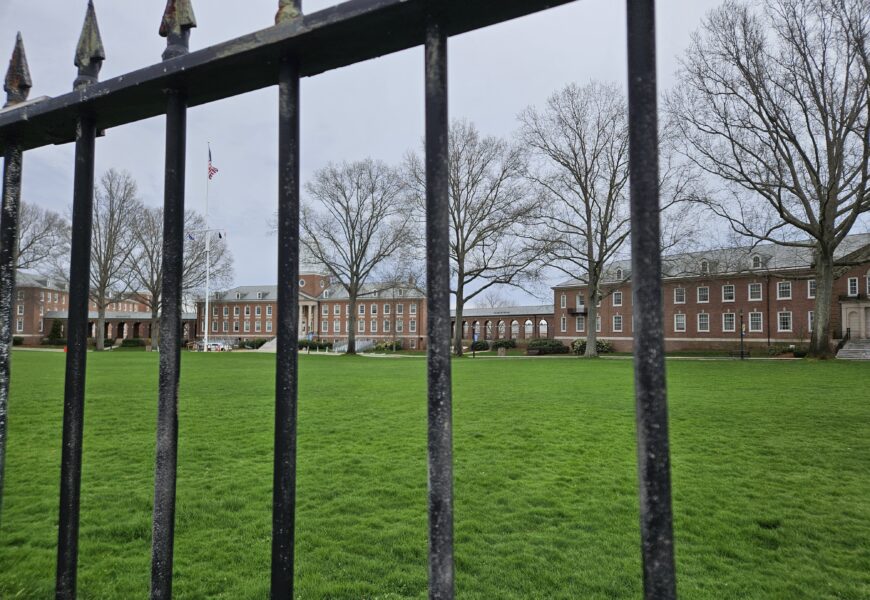Courtesy of Claire Hlotyak
Like an alarm, every morning at 8 a.m. Connecticut College students awaken to the Star Spangled Banner blasting from across the street. While in class, you may be alarmed to hear the sound of gun drills and alarms, or while walking in your dorm hall on a Friday night, you may see cadets in the halls. One’s time here at our small liberal arts college is often intersected with the militant sounds and environment of the United States Coast Guard Academy (CGA). With our sports teams frequently competing against the Academy and having cadets in our courses, one wonders what interactions do our two schools have outside these boundaries of academics and sports? Further, why aren’t our two schools using the opportunities one another provides to create a stronger relationship than the one we currently have?
Since the beginning of our establishment across the road from the U.S. Coast Guard Academy in April 1911, we have had a complex history of engagement with the institution. During the foundational days of Conn as a women’s college in New London, the interactions with the CGA started as dance events between our two institutions to have the students connect and establish “relationships” (both institutional and intimate). Noting from the book “A History of Connecticut College” written in 1982 to document the existence and memory of our school, during the declaration of World War I on April 6, 1917, the Connecticut College women “assumed the role of the later USO, entertaining the Navy and Coast Guard personnel at Fort Trumbull; these were pleasant occasions, though students realized that they would probably never see their escorts again. Impromptu dances were held in Thames, usually to Victorian records, and in return, girls were in demand for dances in town.”
Other times, the CGA showed support for our college students during times of trouble, such as the Jane Addams fire of February 5, 1968, and assisted in moving students to new housing on campus. Our relationship with the CGA in terms of social life from its foundation and to this day has been old-fashioned in spirit, with an emphasis on cadets forming relationships with the Conn women and assisting the women of our campus through “challenges.” Without updated traditions or connections with the CGA, our relationship is frozen in time.
One action our College has taken to continue our relationship was signing a new Memorandum of Agreement in 2020, renewing a 40-year partnership between our schools and instilling that we would continue our collaboration with the CGA. A past Conn news article states that the Memorandum of Agreement, “establishes a firm commitment from both institutions to continuing regular dialogue on opportunities for collaboration; establishes a governance structure to identify, examine, propose and implement new resource-specific sharing arrangements; and continues long-standing arrangements for cross-registration of students and sharing of campus facilities.” With this, we took a stand to connect our institutions in academics, athletics, and events on campus to support the mission of both schools and harness our skills to help our students. Has this potential been met?
Looking from an academic standpoint, one of our key relationships is the course exchange program, which allows students to take classes and learn in two different and separate environments.
Professor Dooling, Vice President for Strategic Initiatives, said, “Since 2010, a total of 345 cadets and 107 Conn students have participated in our course exchange program.” In addition, “ballroom dance accounts for almost half of the cadet course enrollments over this period (159 to be exact).”
The number of cadets attending Conn courses is almost triple the amount of Conn students at the CGA. With our institution opening our courses for elective credits for the Academy, one may wonder, what do they offer us?
As part of the Memorandum of Agreement, the CGA opened up limited summer courses for Conn students to participate in starting last year during summer 2023 from June 12 to July 21, offering four courses: Calculus II, Macroeconomic Principles, Organizational Behavior and Leadership, and Engineering Mechanics – Statistics. With our institution opening up most of our classes to the Cadets, it is a question why the Academy only opens up four courses for our students. It could be attributed to the classified classes that aren’t available for the general public to access and that students could take these same courses or similar already at our institution. At the same time, we provide the academy with a large array of classes not currently available at their school. Surely there has to be a larger selection of courses that aren’t considered classified other than just four math and engineering courses.
Part of the low numbers may be due to a sense of anxiety with attending courses at a secretive institution one doesn’t know, especially a government-run military institution. Our relationship with the Academy feels one-sided, with students from the Academy coming here for academics while their campus feels exclusive behind metal gates.
Further, there is so much unused potential with our programs that overlap, such as in government, mathematics, architecture, and environmental studies and the connections our institutions could establish to advance our programs further together. By allowing more open classes for students from Conn to attend, students could gain a governmental perspective from the CGA on their intended major and further expand their views concerning their field of interest. Additionally, it would allow students from two campuses to interact and collaborate on their passions and learn from each other.
These days, one might see a Coast Guard cadet from time to time on campus, whether it be in classes on campus, in your dorm hall on a Friday night, or out in local spots such as coffee shops in New London or Target, but with little to no established relations, we feel no connection. The Coast Guard Academy is that neighbor you may only see entering and leaving their home, having only had slight interaction. You know who each other are, but you don’t know anything about them.
With such profound resources both institutions have and provide for their students, why have we not seen our schools take advantage of the opportunities it could provide in connecting our students, future leaders, innovators, and minds of our nation from a liberal arts and a US government military perspective? With the announcement of our new president, I hope that our college can make a move to continue foraging our relationship with the U.S. Coast Guard Academy, one that allows students to explore classes and create new connections with other students, strengthening our connections to each other for a new future.










